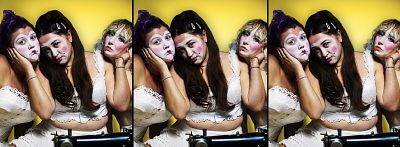
Hemlines
Click here if you liked this article 6 ![]()
https://www.melbournefringe.com.au
Date Reviewed: 02/10/2025
At the Melbourne Fringe, the performance space at Explosives Factory became something between a sewing room and a fever dream. Hemlines, devised and performed by Alicia Badger, Madison Chippendale, and Lana Filies (a.k.a. Moon Bureau), promised whimsy, rebellion, and a feminist chorus line of theatrical invention. What unfolded was part musical theatre, part surreal cabaret, part costume-drama séance — a patchwork stitched together from scraps of history, humour, and girlhood myth.
The three women arrive dressed in white pyjama-like garments, faces painted, arms graceful. Against a black backdrop, they braid together long strands of red and yellow ribbon, their movements fairy-like, their smiles soft. As the braid tightens, their freedom constricts — a delicate image of labour, of bonds, of tradition knotted into beauty. A pink tape measure appears, the same shade as their painted lips, pulled out with a rhythmic snap. Measurement here is both playful and sinister: the sound of the tape sliding in and out becomes a beat in itself, but its presence lingers as a reminder of women’s bodies, quantified and judged.
Soon the sewing room transforms into something stranger. Dresses are held up in admiration or disdain, mirrors consulted, wigs brushed. Flossie (Filies), described by Doris (Chippendale) as “sickly sweet,” writhes with clumsiness, her ribbon tangled in her long hair. Eleanor (Badger), with a heart shape painted prominently on her face, exudes ambition and hauteur. Doris controls the room with comic assurance — one moment launching into an Irish jig, the next puffing theatrically on a cigarette. Their dynamic is archetypal: the dreamer, the clown, the taskmaster. Yet their interplay is more chaotic than controlled, often leaning into slapstick over polish.
The sewing room becomes a stage for rebellion. Aprons printed with oiled male torsos appear — abs glistening, hands coyly covering their manhood. The audience chuckles, a reversal of objectification rendered in polyester. Later, scrolls are unfurled chronicling the history of dresses: Marie Antoinette’s gowns as wide as doors, Jackie Kennedy’s pink suit, Madonna’s cone bra, Audrey Hepburn’s black Givenchy. Fashion becomes a ledger of women’s lives — a record of rebellion and conformity, art and armour. In its strongest moments, Hemlines insists that garments are never just garments: they are politics, survival, and spectacle stitched into form.
But the show is deliberately messy, its seams visible. Songs emerge in bursts — sometimes tightly harmonised, sometimes undercut by shaky articulation or competing volume from live percussion. Choreography swings from elegance to chaos. Filies belts a damsel-in-distress lament under pink light, hand to forehead, before breaking into a mirror pep-talk that lands somewhere between tragic and comic. The tonal shifts can be jarring, but they also speak to the contradictions of femininity itself: earnestness one moment, absurdity the next.
Narratively, Hemlines weaves strands of myth and satire. Flossie is banished for trusting a man; Eleanor is accused of altering a sacred pattern; Doris smokes and jigs. “Genny with a G” — a giant needle — becomes a talisman, the “eye” through which women see the world. The history of hemlines becomes an allegory for power, constraint, and aspiration, though at times the script feels more like a collage than a coherent tapestry.
Still, there are flashes of brilliance. The rhythmic use of the tape measure, snapping and retracting with percussive beauty. The dancers draping themselves in swathes of red, yellow, and orange fabric, caught in foggy light, their laughter infectious. A jig-off between Doris and Flossie, complete with jokes about feet and fetishism, that sends the crowd into delighted applause. The comedy is often strongest when the performers embrace silliness rather than striving for profundity.
By its finale, the sewing room feels less like a factory and more like a found family. Dresses are laid out, apologies exchanged, laughter shared. They make a gown for Flossie, pink fabric trailing like an echo of centuries of fashion history. “We take pride in our work,” Doris insists, “and in each other.” For all its rough edges — muffled lyrics, uneven pacing, ideas that don’t always land — the show closes on a note of solidarity.
Hemlines is not seamless. At times, it feels like three different plays stitched into one: a feminist fable, a vaudeville romp, and a scrapbook of fashion history. But its heart is undeniable. Badger, Chippendale, and Filies throw themselves into their roles with gusto, their chemistry carrying even the messiest passages. The piece captures something of the joy and frustration of collective creation — sisters in arms, bound not by choice but by circumstance, inventing their own rituals out of lace, laughter, and labour.
Like the garments it celebrates, Hemlines is imperfect, sometimes ill-fitting, but undeniably alive. It makes its audience laugh, squirm, and reflect in equal measure. For a Fringe festival work, that mix of audacity and imperfection feels exactly right.
Reviewed by Scarlet Thomas